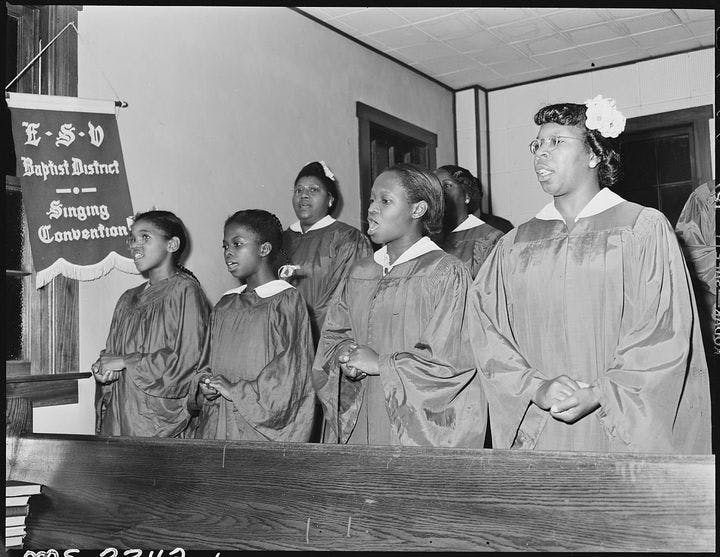Summer 2013
Coming Soon to a Pew Near You: New Hymns
– The Wilson Quarterly
Make way for new hymnals.
If you’re a churchgoer who believes that Sunday worship would not be the same without your most cherished hymns, you may not sing hallelujah at the thought of new hymnals. After all, the old music is still going strong. Hymns pass from generation to generation. On Christmas Eve, young and old belt out “O Come, All Ye Faithful” with scarcely an eye in the sanctuary turned toward a hymnbook.
But worshipers may soon find that they no longer know all the hymns by heart. That’s because it’s a “banner year” for new hymnbooks, writes Mary Louise Bringle, professor of religion at Brevard College in North Carolina and chair of the Presbyterian Committee on Congregational Song, in Christian Century.
In 2013, two branches of the Reformed Church, as well as the Presbyterian Church (U.S.A.), are rolling out new editions. (Bringle’s Committee on Congregational Song compiled Glory to God, the new Presbyterian volume.) Several other Protestant churches overhauled hymnals recently: the two biggest Lutheran denominations in 2006 and the Southern Baptist Convention in 2008. GIA Publications, a publisher of hymnals for Catholic churches, issued new volumes in 2011.
What’s behind the boom? For starters, many American churches now sing to the heavens with “praise choruses,” which shatter the conventions of old-fashioned hymnody. Where traditional hymns feature different lyrical verses across musically identical stanzas, praise choruses circle back to simple lyrical refrains, many of them drawn directly from biblical passages, while varying the music by stanza. The first praise choruses were composed by Christians living in “Jesus communes” in the 1970s. The Christian hippies scandalized purists by jettisoning organists in favor of guitarists strumming basic chords. “While factionalism ensued — the infamous ‘worship wars’ in which some decried praise choruses as simplistic while others denounced traditional hymns as stodgy — the resultant revolution in congregational song has been undeniable,” Bringle writes.
But hymnals printed in the 20th century — each edition usually lasts decades — pay praise choruses little heed. Bringle says the new batch of hymnals rightly acknowledges the genre, even if the worship wars still simmer. “Congregations that prefer some blend of old and new stand to benefit from collections that contain the best of both worlds.”
For the most part, the old hymnals also preceded the arrival of worship songs from outside the United States. In the past few decades, church music directors have been drawn to the sounds and driving rhythms of African, Latin American, and Asian Christian communities. It’s about time American hymnals incorporate songs from the world church, Bringle says.
The latest hymnals reflect a boom in new hymns written in English, as well. Not since the middle of the 19th century have songwriters in the English-speaking world — especially the United States, Canada, England, Scotland, and New Zealand — written so many new compositions. The songs highlight less known biblical characters — does the Ethiopian eunuch ring a bell? — or allude to issues such as aging that songwriters in earlier eras eschewed.
Even old classics need a makeover before they’re printed in new hymnals. Teams of church theologians and musicians police lyrics for too many unnecessary references to God as male (“Father,” “King,” and “Lord” all qualify) or undue use of archaic terms such as “thee” and “ye.” (“O Come, All Ye Faithful” evidently transcends this scrutiny.) Bringle says compromises are common. “This approach to diversity means that the next generation of hymnbooks will be eclectic and wide open to a criticism of inconsistency.” Better that than undemocratic uniformity.
In an age when many congregations follow the words and music on overhead projections when singing hymns, should publishers still bother with printed hymnals? “Projection is ephemeral,” Bringle counters; “a book is a more lasting artifact.” Books don’t malfunction or require technical assistance. They go places where screens often can’t: outdoors, on retreats, in Sunday school. The books themselves bring people together. “Couples or parents and children enjoy the intimacy of sharing the same physical object. An older person’s fingers can point out words or notes to a younger person.” And singing from a hymnal offers precious context. “Congregation members are not simply privy to the passages a worship leader has selected, whether in scripture or in song, but are exposed to the church’s fuller repertoire,” she writes. “They can encounter songs they know and love alongside ones they do not (or do not know yet).”
Happily, hymn publishers haven’t abandoned print. They offer digital companions in addition to print volumes for congregations that use screens.
But will the revamped editions—replete with praise anthems, international tunes, and hymns partially scrubbed of anachronisms — be accepted? Expect ample grumbling from people attached to old versions, Bringle warns. Some congregants bristle at the idea of singing “foreign” songs, for example. Bringle calls on the faithful to put aside their reservations “in order to sing the heart songs of our neighbors, freshly available to us in new hymnals — even when the old ones have worn so well.”
THE SOURCE: “Singing From One Book” by Mary Louise Bringle. The Christian Century, May 15, 2013.
Photo courtesy of Wikimedia Commons
